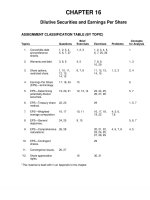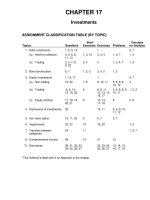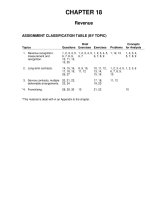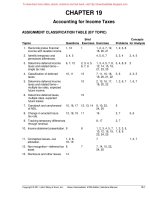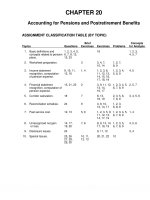Intermediate accounting IFRS 3rd ch16
Bạn đang xem bản rút gọn của tài liệu. Xem và tải ngay bản đầy đủ của tài liệu tại đây (3.66 MB, 111 trang )
Prepared by
Coby Harmon
University of California, Santa Barbara
Westmont College
16-1
CHAPTER 16
Dilutive Securities
and Earnings per Share
LEARNING OBJECTIVES
After studying this chapter, you should be able to:
1. Describe the accounting for the
issuance, conversion, and
retirement of convertible
securities.
2. Describe the accounting for
share warrants and for share
warrants issued with other
securities.
16-2
3. Describe the accounting and
reporting for share
compensation plans.
4. Compute basic earnings per
share.
5. Compute diluted earnings per
share.
PREVIEW OF CHAPTER 16
16-3
Intermediate Accounting
IFRS 3rd Edition
Kieso ● Weygandt ● Warfield
Dilutive Securities
LEARNING OBJECTIVE 1
Describe the accounting for the
issuance, conversion, and
retirement of convertible securities.
Debt and Equity
Should companies report these instruments as a liability
or equity?
Share Options
16-4
Convertible
Securities
Preference
Shares
LO 1
Convertible Debt
Bonds which can be changed into other corporate
securities are called convertible bonds.
Benefit of a Bond (guaranteed interest and principal)
+
Privilege of Exchanging it for Shares
(at the holder’s option)
16-5
LO 1
Convertible Debt
Two main reasons corporations issue convertibles:
To raise equity capital without giving up more
ownership control than necessary.
Obtain debt financing at cheaper rates.
16-6
LO 1
Convertible Debt
Accounting for Convertible Debt
Convertible debt is accounted for as a compound instrument.
Companies use the “with-and-without” method to value
compound instruments.
ILLUSTRATION 16.1
Convertible Debt Components
16-7
LO 1
Accounting for Convertible Debt
Implementation of the with-and-without approach:
1. First, determine total fair value of convertible debt with both
the liability and equity component.
2. Second, determine liability component by computing net
present value of all contractual future cash flows discounted
at the market rate of interest.
3. Finally, subtract liability component estimated in second
step from fair value of convertible debt (issue proceeds) to
arrive at the equity component.
16-8
LO 1
Accounting for Convertible Debt
Accounting at Time of Issuance
Illustration: Roche Group (CHE) issues 2,000 convertible
bonds at the beginning of 2019. The bonds have a four-year
term with a stated rate of interest of 6 percent and are issued at
par with a face value of €1,000 per bond (the total proceeds
received from issuance of the bonds are €2,000,000). Interest
is payable annually at December 31. Each bond is convertible
into 250 ordinary shares with a par value of €1. The market rate
of interest on similar non-convertible debt is 9 percent.
16-9
LO 1
Accounting for Convertible Debt
ILLUSTRATION 16.2
Time Diagram for
Convertible Bond
Accounting
at Time of
Issuance
ILLUSTRATION 16.3
Fair Value of Liability
Component of Convertible Bond
ILLUSTRATION 16.4
Equity Component of
Convertible Bond
16-10
LO 1
Accounting for Convertible Debt
Accounting at Time of Issuance
ILLUSTRATION 16.3
Fair Value of Liability
Component of Convertible Bond
ILLUSTRATION 16.4
Equity Component of
Convertible Bond
Journal
Entry
Cash 2,000,000
Bonds Payable
1,805,606
Share Premium—Conversion Equity
16-11
194,394
LO 1
Accounting for Convertible Debt
Settlement of Convertible Bonds
Repurchase at Maturity. If the bonds are not converted at
maturity, Roche makes the following entry to pay off the
convertible debtholders.
Bonds Payable
Cash
2,000,000
2,000,000
NOTE: The amount originally allocated to equity of €194,384 either remains
in the Share Premium—Conversion Equity account or is transferred to the
Share Premium—Ordinary account.
16-12
LO 1
Settlement of Convertible Bonds
Conversion of Bonds at Maturity. If the bonds are converted
at maturity, Roche makes the following entry.
Share Premium—Conversion Equity 194,394
Bonds Payable
2,000,000
Share Capital—Ordinary
Share Premium—Ordinary
500,000
1,694,394
NOTE: The amount originally allocated to equity of €194,384 is transferred to
the Share Premium—Ordinary account.
16-13
LO 1
Settlement of Convertible Bonds
Conversion of Bonds before Maturity.
ILLUSTRATION 16.5
Convertible Bond Amortization Schedule
16-14
LO 1
Settlement of Convertible Bonds
Conversion of Bonds before Maturity. Assuming that Roche
converts its bonds into ordinary shares on December 31, 2020.
Share Premium—Conversion Equity 194,374
Bonds Payable
1,894,464
Share Capital—Ordinary
Share Premium—Ordinary
500,000
1,588,838
NOTE: The amount originally allocated to equity (€194,374) is transferred to
the Share Premium—Ordinary account.
16-15
LO 1
Settlement of Convertible Bonds
Repurchase before Maturity. Roche determines the fair value
of the liability component of the convertible bonds at December
31, 2020, and then subtracts the fair value of the convertible
bond issue (including the equity component) to arrive at the
value of the equity. Then,
1. The difference between the consideration allocated to the
liability component and the carrying amount of the liability is
recognized as a gain or loss, and
2. The amount of consideration relating to the equity
component is recognized (as a reduction) in equity.
16-16
LO 1
Settlement of Convertible Bonds
Repurchase before Maturity. Assume:
16-17
Fair value of the convertible debt (including both liability
and equity components), based on market prices at
December 31, 2020, is €1,965,000.
The fair value of the liability component is €1,904,900. This
amount is based on computing the present value of a nonconvertible bond with a two-year term (which corresponds
to the shortened time to maturity of the repurchased
bonds.)
LO 1
Settlement of Convertible Bonds
First, determine the gain or loss on the liability component.
ILLUSTRATION 16.6
Next, determine any adjustment to the equity.
ILLUSTRATION 16.7
16-18
LO 1
Settlement of Convertible Bonds
ILLUSTRATION 16.6 & 7
Bonds Payable 1,894,464
Journal
Entry
Share Premium—Conversion Equity
Loss on Repurchase
Cash
16-19
60,100
10,436
1,965,000
LO 1
Convertible Debt
Induced Conversion
16-20
Issuer wishes to encourage prompt conversion.
Issuer offers additional consideration, called a
“sweetener,” to induce conversion.
Sweetener is an expense of the current period.
LO 1
Induced Conversion
Illustration: Helloid, Inc. has outstanding $1,000,000 par value
convertible debentures convertible into 100,000 ordinary shares
($1 par value). When issued, Helloid recorded Share Premium
—Conversions Equity of $15,000. Helloid wishes to reduce its
annual interest cost. To do so, Helloid agrees to pay the holders
of its convertible debentures an additional $80,000 if they will
convert. Assuming conversion occurs, Helloid makes the
following entry.
16-21
LO 1
Induced Conversion
Illustration: Helloid makes the following entry.
Conversion Expense 80,000
Share Premium—Conversion Equity 15,000
Bonds Payable
1,000,000
Share Capital—Ordinary
Share Premium—Ordinary
Cash
16-22
100,000
915,000
80,000
LO 1
Convertible Preference Shares
Convertible preference shares include an option for the
holder to convert preference shares into a fixed number of
ordinary shares.
16-23
Convertible preference shares are reported as part of
equity.
When preference shares are converted or
repurchased, there is no gain or loss recognized.
LO 1
Convertible Preference Shares
Illustration: Morse AG issues 1,000 convertible preference
shares that have a par value of €1 per share. The shares
were issued at a price of €200 per share. The journal entry to
record this transaction is as follows.
Cash (1,000 x €200)
200,000
Share Capital—Preference (1,000 x €1)
Share Premium—Conversion Equity
16-24
1,000
199,000
LO 1
Convertible Preference Shares
Illustration: If each share is subsequently converted into 25
each ordinary shares (€2 par value) that have a fair value of
€410,000, the journal entry to record the conversion is as
follows.
Share Capital—Preference
1,000
Share Premium—Conversion Equity 199,000
Share Capital—Ordinary (1,000 x 25 x €2)
Share Premium—Ordinary
16-25
50,000
150,000
LO 1





